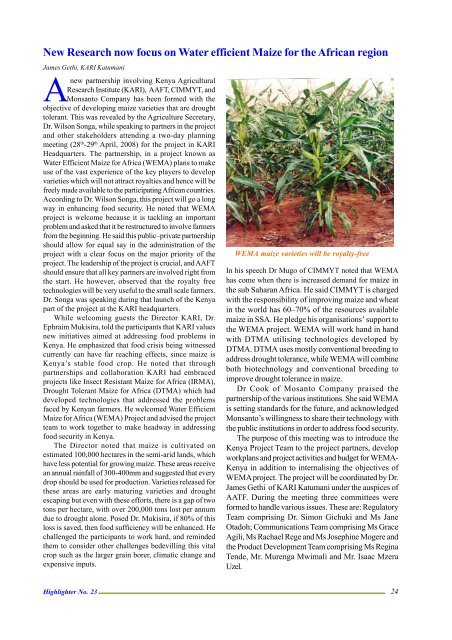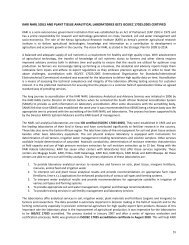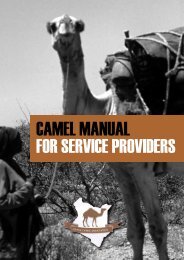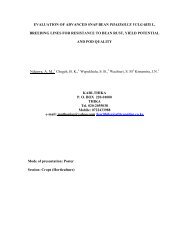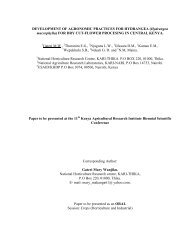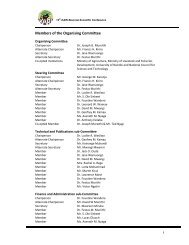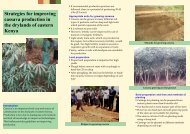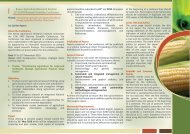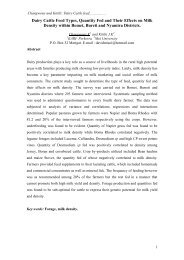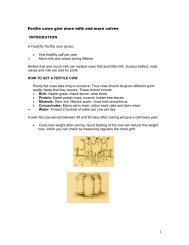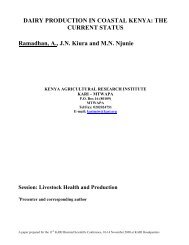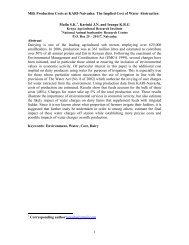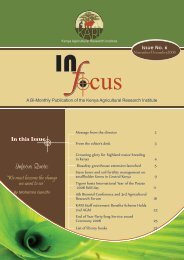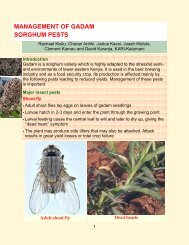January - June 2008 - Kenya Agricultural Research Institute
January - June 2008 - Kenya Agricultural Research Institute
January - June 2008 - Kenya Agricultural Research Institute
You also want an ePaper? Increase the reach of your titles
YUMPU automatically turns print PDFs into web optimized ePapers that Google loves.
New <strong>Research</strong> now focus on Water efficient Maize for the African region<br />
James Gethi, KARI Katumani<br />
Anew partnership involving <strong>Kenya</strong> <strong>Agricultural</strong><br />
<strong>Research</strong> <strong>Institute</strong> (KARI), AAFT, CIMMYT, and<br />
Monsanto Company has been formed with the<br />
objective of developing maize varieties that are drought<br />
tolerant. This was revealed by the Agriculture Secretary,<br />
Dr. Wilson Songa, while speaking to partners in the project<br />
and other stakeholders attending a two-day planning<br />
meeting (28 th -29 th April, <strong>2008</strong>) for the project in KARI<br />
Headquarters. The partnership, in a project known as<br />
Water Efficient Maize for Africa (WEMA) plans to make<br />
use of the vast experience of the key players to develop<br />
varieties which will not attract royalties and hence will be<br />
freely made available to the participating African countries.<br />
According to Dr. Wilson Songa, this project will go a long<br />
way in enhancing food security. He noted that WEMA<br />
project is welcome because it is tackling an important<br />
problem and asked that it be restructured to involve farmers<br />
from the beginning. He said this public–private partnership<br />
should allow for equal say in the administration of the<br />
project with a clear focus on the major priority of the<br />
project. The leadership of the project is crucial, and AAFT<br />
should ensure that all key partners are involved right from<br />
the start. He however, observed that the royalty free<br />
technologies will be very useful to the small scale farmers.<br />
Dr. Songa was speaking during that launch of the <strong>Kenya</strong><br />
part of the project at the KARI headquarters.<br />
While welcoming guests the Director KARI, Dr.<br />
Ephraim Mukisira, told the participants that KARI values<br />
new initiatives aimed at addressing food problems in<br />
<strong>Kenya</strong>. He emphasized that food crisis being witnessed<br />
currently can have far reaching effects, since maize is<br />
<strong>Kenya</strong>’s stable food crop. He noted that through<br />
partnerships and collaboration KARI had embraced<br />
projects like Insect Resistant Maize for Africa (IRMA),<br />
Drought Tolerant Maize for Africa (DTMA) which had<br />
developed technologies that addressed the problems<br />
faced by <strong>Kenya</strong>n farmers. He welcomed Water Efficient<br />
Maize for Africa (WEMA) Project and advised the project<br />
team to work together to make headway in addressing<br />
food security in <strong>Kenya</strong>.<br />
The Director noted that maize is cultivated on<br />
estimated 100,000 hectares in the semi-arid lands, which<br />
have less potential for growing maize. These areas receive<br />
an annual rainfall of 300-400mm and suggested that every<br />
drop should be used for production. Varieties released for<br />
these areas are early maturing varieties and drought<br />
escaping but even with these efforts, there is a gap of two<br />
tons per hectare, with over 200,000 tons lost per annum<br />
due to drought alone. Posed Dr. Mukisira, if 80% of this<br />
loss is saved, then food sufficiency will be enhanced. He<br />
challenged the participants to work hard, and reminded<br />
them to consider other challenges bedevilling this vital<br />
crop such as the larger grain borer, climatic change and<br />
expensive inputs.<br />
WEMA maize varieties will be royalty-free<br />
In his speech Dr Mugo of CIMMYT noted that WEMA<br />
has come when there is increased demand for maize in<br />
the sub Saharan Africa. He said CIMMYT is charged<br />
with the responsibility of improving maize and wheat<br />
in the world has 60–70% of the resources available<br />
maize in SSA. He pledge his organisations’ support to<br />
the WEMA project. WEMA will work hand in hand<br />
with DTMA utilising technologies developed by<br />
DTMA. DTMA uses mostly conventional breeding to<br />
address drought tolerance, while WEMA will combine<br />
both biotechnology and conventional breeding to<br />
improve drought tolerance in maize.<br />
Dr Cook of Mosanto Company praised the<br />
partnership of the various institutions. She said WEMA<br />
is setting standards for the future, and acknowledged<br />
Monsanto’s willingness to share their technology with<br />
the public institutions in order to address food security.<br />
The purpose of this meeting was to introduce the<br />
<strong>Kenya</strong> Project Team to the project partners, develop<br />
workplans and project activities and budget for WEMA-<br />
<strong>Kenya</strong> in addition to internalising the objectives of<br />
WEMA project. The project will be coordinated by Dr.<br />
James Gethi of KARI Katumani under the auspices of<br />
AATF. During the meeting three committees were<br />
formed to handle various issues. These are: Regulatory<br />
Team comprising Dr. Simon Gichuki and Ms Jane<br />
Otadoh; Communications Team comprising Ms Grace<br />
Agili, Ms Rachael Rege and Ms Josephine Mogere and<br />
the Product Development Team comprising Ms Regina<br />
Tende, Mr. Murenga Mwimali and Mr. Isaac Mzera<br />
Uzel.<br />
Highlighter No. 23<br />
24


